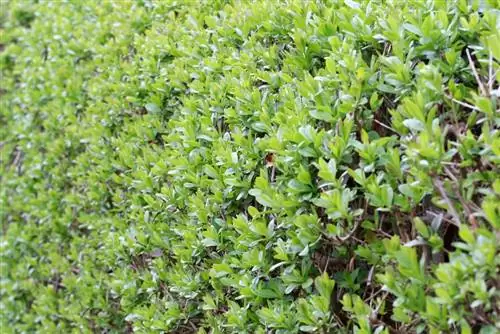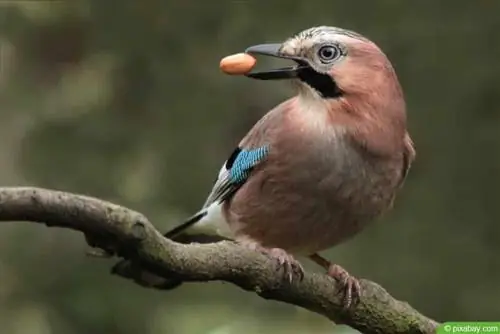- Author admin [email protected].
- Public 2023-12-17 03:39.
- Last modified 2025-01-24 12:45.
What we love about privet is its fast growth. In no time he conjures up a high, opaque hedge in our garden. But unfortunately his growth doesn't just stop once he has reached the ideal shape for us. Its branches strive diligently both upwards and to the side. When can we hope for what kind of growth or fear time-consuming cutting measures?
The typical growth rate
Privet grows quickly. While a young plant still makes modest progress, depending on the variety it later produces a proud annual growth of approx. 50 cm.
- at the age of around 3 years she is approx. 80 cm high
- after 5 years up to 1.5 m
- then progress in 40-50 cm increments
In the wild, the bush left to its own devices can easily reach a height of up to 5 m within a few years. In a private garden, on the other hand, a large proportion of the new shoots fall victim to the scissors so that optimal branching is promoted. It can also hardly grow beyond 2 m because that is the ideal hedge height. A specimen is rarely cultivated as a solitaire. But even then this is usually limited in height.
Growth in two stages
The privet experiences two growth spurts within one growing season. The first and stronger growth spurt can be expected in spring, as soon as the days become longer and warmer. The second shoot begins around the end of May. A previous cut stimulates the growth in length.
Important growth factors
It's not just the scissors that can influence his growth. The following factors also determine whether and how quickly the privet grows:
- variety-specific growth characteristics
- Site conditions
- Soil texture
- Care
- the he alth status of the plant
Variety-specific properties

Not every type of privet grows equally quickly. Yes, there are even varieties that can be described as slow-growing. Here are a few examples:
- Dwarf privet only grows to a height of around 80 to 100 cm
- the annual increase is lower than with other species
- the common privet, bot. Privet vulgare, grows 2.5 to 4 m high
- the variety “Atrovirens” even reaches 5 m
Since this olive tree plant is available in many varieties in this country, you should inquire carefully about their respective growth characteristics when planting and whether the future location harmonizes with your requirements.
Site conditions
Privet needs sun in order to sprout numerous plants and to achieve the length growth expected of it. A partially shaded spot is also tolerated, but may result in weaker growth. What is out of the question is a shadowy existence. There, even this vigorous plant will just worry about itself.
Tip:
When planting a privet hedge, make sure there is enough space between the individual plants so that they do not interfere with each other. If there are any gaps, you can easily close them later by replanting.
Soil texture
The privet is only in good hands and grows as its genes allow in nutrient-rich, loose and well-drained soil. Places that tend to be waterlogged or dry should be avoided. In the first case, a drainage layer created before planting can help. Weeds should be consistently removed before planting and afterwards, as they would compete with it for nutrients and thereby inhibit its growth.
Tip:
Provide the young plant with a long-term fertilizer when planting so that rapid growth is possible right from the start.
Care
In order for the privet to fully exploit its growth potential, it must be supplied with sufficient nutrients in a timely manner.
- organic fertilization in spring before budding is ideal
- for example with compost
- A commercial green manure can also be used
- a layer of mulch provides nutrients
- prevents excessive evaporation of soil moisture
- Low-lime soils must be additionally limed
Privet is not a heavy user of water, but prolonged drought stunts its growth. Therefore, ensure a balanced water balance by watering on hot days.
Tip:
Don't overdo fertilizing. An oversupply of nutrients does not necessarily increase the rate of growth. On the contrary, the privet can then slow down growth or even stop it completely.
Plant he alth status
Various species of beetles and the tiny little aphids occasionally get in the way of the growth of these plants.
- A weak infestation is usually survived well
- Severe infestations should be combated
- otherwise the new growth falls short of expectations

The black weevil can be really dangerous. Not only does it slow down growth, but if it occurs frequently it can cost the plant its life. Fungal diseases can also be responsible for poor growth. They must either be combated with a suitable agent or the affected part of the shoots must be removed. It is best if diseases and pests do not appear in the first place. That's why the privet must be cared for and cared for according to its preferences.
Promoting growth with cutting
Pruning privet plants regularly is not just about giving them a certain shape. The growth of its shoots is also stimulated by regular cuts. Without careful pruning, the lower parts of the plant would also become bare, as sunlight would barely or only insufficiently reach them. Proper pruning, where the upper part of the plant is cut narrower than the lower part, ensures better light penetration. This stimulates new growth even in lower areas.
- cut twice a year
- in spring and early summer
A privet that is not pruned only grows taller while hardly forming any branches.
Responding to lack of growth
A privet hedge that has not been trimmed properly for a long time can weaken so significantly when new growth occurs in the spring that pruning close to the ground is necessary. Of course, the other care measures also need to be put to the test at the same time.






